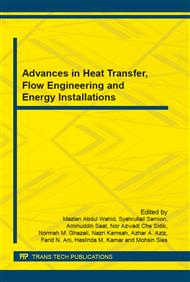[1]
Akazawa T, Kawahara S, Abe Y, Makino M, Itou D. Development of a High Performance Scroll Compressor for Automotive air conditioners. In: Proceedings of Purdue Compressor Technology Conference1996. pp.331-16.
Google Scholar
[2]
Yi F, Qian Y. Developing a Compact Automotive Scroll Compressor. In: Proceedings of Purdue Compressor Technology Conference2008. p.1106.
Google Scholar
[3]
Hu X, Qu Z, Yang X, Sun J. Theoretical study on frictional losses of a novel automotive swing vane compressor. Int J Refrigeration. 2013; 36: 758-67.
DOI: 10.1016/j.ijrefrig.2012.11.001
Google Scholar
[4]
Chang KY. A Theoretical and Experimental Study of an Oil-Flooded Rotary Sliding-Vane Compressor: PhD Thesis University of Strathclyde; (1983).
Google Scholar
[5]
Katare PK, Kriplani VM. Decade Developments of Rotary Compressor. International Journal of Engineering and Technology. 2012; 2: 1965-73.
Google Scholar
[6]
Al-Hawaj O. Theoretical modeling of sliding vane compressor with leakage. Int J Refrigeration. 2009; 32: 1555-62.
DOI: 10.1016/j.ijrefrig.2009.07.005
Google Scholar
[7]
Teh YL, Ooi KT. Theoretical study of a novel refrigeration compressor – Part I: Design of the revolving vane (RV) compressor and its frictional losses. Int J Refrigeration. 2009; 32: 1092-102.
DOI: 10.1016/j.ijrefrig.2008.09.006
Google Scholar
[8]
Ko Y, Park S, Jin S, Kim B, Jeong JH. The selection of volume ratio of two-stage rotary compressor and its effects on air-to-water heat pump with flash tank cycle. Applied Energy. 2013; 104: 187-96.
DOI: 10.1016/j.apenergy.2012.11.021
Google Scholar
[9]
Gillespie JE. Improvement In Rotary Pump. US Patent: US141000 A; 1873.
Google Scholar
[10]
Walter JP. Rotary Pump. US Patent: US1444269 A; (1923).
Google Scholar
[11]
Camilo VN. Rotary Vacuum And Compressor Pump. US Patent US2672282 A; (1954).
Google Scholar
[12]
Adalbert G, Hess J, Linder E. Pressure-Sealed Compressor. US Patent US3852003 A; (1974).
Google Scholar
[13]
Adalbert G, Vysiotis T. Vane Compressor, Particularly A Cooling Medium Compressor For Use In Air-Conditioning Equipment of A Vehicle. US Patent US4505656 A; (1985).
Google Scholar
[14]
Yang J-S, Mei L, Noh K-Y, Moon S-H, Sa B-D, Choi G-M, et al. A sensitivity study of size parameters in a twin-type rolling piston compressor. Int J Refrigeration. 2013; 36: 786-94.
DOI: 10.1016/j.ijrefrig.2012.08.027
Google Scholar
[15]
Matsuzaka T, Nagatomo S. Rolling piston type rotary compressor performance analysis. In: Proceedings of Purdue Compressor Technology Conference1982. p.149–58.
Google Scholar
[16]
Ozu M, Itami T. Efficiency analysis of power consumption in small hermetic refrigerant rotary compressors. Int J Refrigeration. 1981; 4 (5): 265–70.
DOI: 10.1016/0140-7007(81)90005-0
Google Scholar
[17]
Yanagisawa T, Shimizu T. Friction losses in rolling piston type rotary compressor. III. Int J Refrigeration. 1985; 8 (3): 159–65.
DOI: 10.1016/0140-7007(85)90156-2
Google Scholar
[18]
Bowman JL. Fans, Pumps, and Compressors. Marks' Standard Handbook for Mechanical Engineering1997. pp.14-28.
Google Scholar
[19]
Arora RC. Refrigeration and Air conditioning. New Delhii: Asoke K. Ghosh, PHI Learning Private Limited; (2010).
Google Scholar


